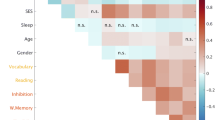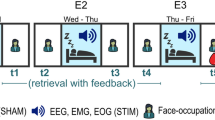The fact of significant heterogeneity in cognitive aging is explained in terms of the influences of both genetic and environmental factors. Brain-derived neurotrophic factor (BDNF) is a neurotrophic factor involved in plasticity processes in the mature brain. The Val66Met polymorphism is a functional polymorphism of the BDNF gene which determines its associations with the cerebral architecture and functions and the efficiency of cognitive functioning. The aim of the present work was to identify aging-related features of the relationship between the Val66Met polymorphism and the efficiency of verbal memory processes as determined in a dichotic test, as well as with background oscillatory brain activity recorded with the eyes closed in 52 EEG leads. The study included 235 young (Y, mean age 21.65 years, SD = 3.18) and 141 older (O, mean age 64.37 years, SD = 6.04) right-handed Caucasians. Differences in memory indicators and EEG activity patterns associated with the BDNF Val66Met polymorphism were detected only in O individuals. During dichotic testing, O subjects with the Val/Val genotype reproduced fewer words from the right ear than carriers of the Met allele. Analysis of the EEG revealed between-genotype differences in focal indicators of asymmetry in the power of the δ, θ, β1, and β2 rhythms, with greater power of rhythms in the central temporal areas of the right hemisphere than the left in the Val/Val genotype, with the opposite ratio in carriers of the Met allele. In the case of the β2 rhythm, similar differences in asymmetry were also characteristic of the parietal-occipital areas of the hemispheres. Indicators of central temporal asymmetry were found to be mediators of the association between the BDNF gene polymorphism and the efficiency of memory. These findings provide the first evidence of age-related differences in the effects of the BDNF Val66Met polymorphism on verbal memory performance and EEG power, and also indicate possible relationships between these genotype-associated parameters.
Similar content being viewed by others
References
Azeredo, L. A., De Nardi, T., Levandowski, M. L., et al., “The brain-derived neurotrophic factor (BDNF) gene Val66Met polymorphism affects memory performance in older adults,” Braz. J. Psychiatry, 39, No. 2, 90–94 (2017).
Belousova, L. V., Volf, N. V., and Bazovkina, D. V., “Dependence of aging-related changes in background brain activation serotonin transporter gene 5-HTTLPR polymorphism in men,” Hum. Physiol., 44, No. 5, 574–580 (2018).
Benjamini, Y. and Hochberg, Y., “Controlling the false discovery rate: A practical and powerful approach to multiple testing,” J. R. Stat. Soc. Ser. B (Methodol.), 57, 289–300 (1995).
Brown, B. M., Castalanelli, N., Rainey-Smith, S. R., et al., “Influence of BDNF Val66Met on the relationship between cardiorespiratory fitness and memory in cognitively normal older adults,” Behav. Brain Res., 362, 103–108 (2019).
Cathomas, F., Vogler, C., Euler-Sigmund, J. C., et al., “Fine-mapping of the brain-derived neurotrophic factor (BDNF) gene supports an association of the Val66Met polymorphism with episodic memory,” Int. J. Neuropsychopharmacol., 13, No. 8, 975–980 (2010).
Colucci-D’Amato L, Speranza L, and Volpicelli, F., “Neurotrophic factor BDNF, physiological functions and therapeutic potential in depression, neurodegeneration and brain cancer,” Int. J. Mol. Sci., 21, No. 20, 7777 (2020).
De Vincenti, A. P., Ríos, A. S., Paratcha, G., and Ledda, F., “Mechanisms that modulate and diversify BDNF functions: Implications for hippocampal synaptic plasticity,” Front. Cell. Neurosci, 13, 135 (2019).
Egan, M. F., Kojima, M., Callicott, J. H., et al., “The BDNF val66met polymorphism affects activity-dependent secretion of BDNF and human memory and hippocampal function,” Cell, 112, 257–269 (2003).
Erickson, K. I., Kim, J. S., Suever, B. L., et al., “Genetic contributions to age-related decline in executive function: a 10-year longitudinal study of COMT and BDNF polymorphisms,” Front. Hum. Neurosci., 2, 11 (2008).
Gajewski, P. D., Hengstler, J. G., Golka, K., et al., “The Met-allele of the BDNF Val66Met polymorphism enhances task switching in elderly,” Neurobiol. Aging, 32, No. 12, 2327, e7–19 (2011).
Gasser, T., Bacher, P., and Mocks, J., “Transformations towards the normal distribution of broad spectral parameters of the EEG,” Electroencephalogr. Clin. Neurophysiol., 53, 119–124 (1982).
Gatt, J. M., Kuan, S. A., Dobson-Stone, C., et al., “Association between BDNF Val66Met polymorphism and trait depression is mediated via resting EEG alpha band activity,” Biol. Psychol., 79, No. 2, 275–284 (2008).
Gruber, M. J., Watrous, A. J., Ekstrom, A. D., et al., “Expected reward modulates encoding-related theta activity before an event,” Neuro-Image, 64, 68–74 (2013).
Guderian, S., Schott, B. H., Richardson-Klavehn, A., and Düzel, E., “Medial temporal theta state before an event predicts episodic encoding success in humans,” Proc. Natl. Acad. Sci. USA, 106, No. 13, 5365–5370 (2009).
Hayes, A. F., “Beyond Baron and Kenny: Statistical mediation analysis in the new millennium,” Commun. Monogr., 76, No. 4, 408–420 (2009).
Hayes, A. F., Introduction to Mediation, Moderation, and Conditional Process Analysis: A Regression-Based Approach, The Guilford Press, New York (2018), 2nd ed.
Ho, B. C., Milev, P., O’Leary, D. S., et al., “Cognitive and magnetic resonance imaging brain morphometric correlates of brain-derived neurotrophic factor Val66Met gene polymorphism in patients with schizophrenia and healthy volunteers,” Arch. Gen. Psychiatry, 63, 731–740 (2006).
Houlihan, L. M., Harris, S. E., Luciano, M., et al., “Replication study of candidate genes for cognitive abilities: the Lothian Birth Cohort 1936,” Genes Brain Behav., 8, 238–247 (2009).
Karnik, M. S., Wang, L., Barch, D. M., et al., “BDNF polymorphism rs6265 and hippocampal structure and memory performance in healthy control subjects,” Psychiatry Res., 178, 425–429 (2010).
Kennedy, K. M., Reese, E. D., Horn, M. M., et al., “BDNF Val66Met polymorphism affects aging of multiple types of memory,” Brain Res., 1612, 104–117 (2015).
Kim, H., “Neural activity that predicts subsequent memory and forgetting: A meta-analysis of 74 fMRI studies,” NeuroImage, 54, 2446–2461 (2011).
Knott, V., Mahoney, C., Kennedy, S., and Evans, K., “EEG power, frequency, asymmetry, and coherence in male depression,” Psychiatry Res., 106, 123–140 (2001).
Kowiański, P., Lietzau, G., Czuba, E., et al., “BDNF: A key factor with multipotent impact on brain signaling and synaptic plasticity,” Cell. Mol. Neurobiol., 38, No. 3, 579–593 (2018).
Lega, B. C., Jacobs, J., and Kahana, M., “Human hippocampal theta oscillations and the formation of episodic memories,” Hippocampus, 22, No. 4, 748–761 (2012).
Li, S., Nguyen, T. L., Wong, E. M., et al., “Genetic and environmental causes of variation in epigenetic aging across the lifespan,” Clin. Epigenet., 12, No. 1, 158 (2020).
Mercado, N. M., Collier, T. J., Sortwell, C. E., and Steece-Collier, K., “BDNF in the aged brain: Translational implications for Parkinson’s disease,” Austin Neurol. Neurosci., 2, No. 2, 1021 (2017).
Merkow, M. B., Burke, J. F., Stein, J. M., and Kahana, M. J., “Prestimulus theta in the human hippocampus predicts subsequent recognition but not recall,” Hippocampus, 24, No. 12, 1562–1569 (2014).
Miyajima, F., Ollier, W., Mayes, A., et al., “Brain-derived neurotrophic factor polymorphism Val66Met influences cognitive abilities in the elderly,” Genes Brain Behav., 7, No. 4, 411–417 (2008).
Moradi, E., Hallikainen, I., Hänninen, T., and Tohka, J., “Alzheimer’s disease neuroimaging initiative. Rey’s auditory verbal learning test scores can be predicted from whole brain MRI in Alzheimer’s disease,” NeuroImage Clin, 13, 415–427 (2016).
Noh, E., Herzmann, G., Curran, T., and de Sa, V. R., “Using single-trial EEG to predict and analyze subsequent memory,” NeuroImage, 84, 712–723 (2014).
Nyberg, L., Boraxbek, C. J., Sörman, D. E., et al., “Biological and environmental predictors of heterogeneity in neurocognitive ageing: Evidence from Betula and other longitudinal studies,” Ageing Res. Rev., 64, 101184 (2020).
Rochart, R., Liu, Q., Fonteh, A. N., et al., “Compromised behavior and gamma power during working memory in cognitively healthy individuals with abnormal CSF amyloid/tau,” Front. Aging Neurosci., 12, 574214 (2020).
Salari, N. and Rose, M., “Dissociation of the functional relevance of different pre-stimulus oscillatory activity for memory formation,” Neuro-Image, 125, 1013–1021 (2016).
Schneider, S. L. and Rose, M., “Intention to encode boosts memory-related pre-stimulus EEG beta power,” NeuroImage, 125, 978–987 (2016).
Schol, S., Schneider, S. L., and Rose, M., “Differential effects of ongoing EEG beta and theta power on memory formation,” PLoS One, 12, No. 2, e0171913 (2017).
Sheikh, H. I., Hayden, E. P., Kryski, K. R., et al., “Genotyping the BDNF rs6265 (val66met) polymorphism by one-step amplified refractory mutation system PCR,” Psychiatr. Genet., 20, No. 3, 109–112 (2010).
Smit, D. J. A., Posthuma, D., Boomsma, D. I., and Geus, E. J. C., “Heritability of background EEG across the power spectrum,” Psychophysiology, 42, 691–697 (2005).
Stacey, J. E., Crook-Rumsey, M., Sumich, A., et al., “Age differences in resting state EEG and their relation to eye movements and cognitive performance,” Neuropsychologia, 157, 107887 (2021).
Volf, N. V. and Privodnova, E. Yu., “Associations between the STin2VNTR polymorphism of the serotonin transporter gene and characteristics of attention during aging depend on the intellectual environment of professional activity,” Zh. Vyssh. Nerv. Deyat., 72, No. 1, 77–86 (2022).
Volf, N. V., Belousova, L. V., Knyazev, G. G., and Kulikov, A. V., “Interac tive effect of 5-HTTLPR genotype and age on sources of cortical rhythms in healthy women,” Int. J. Psychophysiol., 109, 107–115 (2016).
Volf, N. V., Privodnova, E. Yu., and Bazovkina, D. V., “The STin2VNTR polymorphism of the serotonin transporter gene: associations with short-term memory performance in young and elderly subjects,” Zh. Vyssh. Nerv. Deyat., 69, No. 5, 570–576 (2019).
Volf, N. V., Sex Differences in the Functional Organization of Hemispheric Processing of Speech Information, TsBBR Press, Rostov-on-Don (2000).
Ward, D. D., Ande, R., Saunders, N. L., et al., “The BDNF Val66Met polymorphism moderates the effect of cognitive reserve on 36-month cognitive change in healthy older adults,” Alzheimers Dement. (N.Y.), 3,
No. 3, 323–331 (2017).
Yuvara, R., Murugappa, M., Mohamed Ibrahim, N., et al., “On the analysis of EEG power, frequency and asymmetry in Parkinson’s disease during emotion processing,” Behav. Brain Funct., 10, 12 (2014).
Author information
Authors and Affiliations
Corresponding author
Rights and permissions
Springer Nature or its licensor (e.g. a society or other partner) holds exclusive rights to this article under a publishing agreement with the author(s) or other rightsholder(s); author self-archiving of the accepted manuscript version of this article is solely governed by the terms of such publishing agreement and applicable law.
About this article
Cite this article
Volf, N.V., Privodnova, E.Y. Background EEG Activity Mediates the Association between the BDNF Val66Met Polymorphism and Memory during Aging. Neurosci Behav Physi 53, 1469–1477 (2023). https://doi.org/10.1007/s11055-023-01540-3
Received:
Accepted:
Published:
Issue Date:
DOI: https://doi.org/10.1007/s11055-023-01540-3




